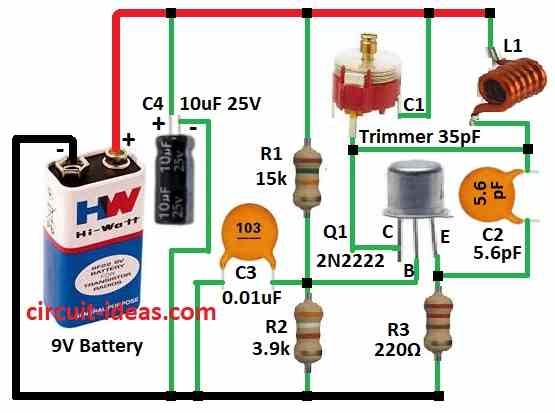Simple FM Radio Jammer Circuit make signal to block normal FM radio.
It send noise or fake signal on same frequency so real FM signal get disturbed.
Main parts:
- Transistor for making signal oscillator
- Capacitors for tuning
- Coil to make radio frequency signal
- Resistors to keep circuit stable
Transistor work like oscillator and make RF signal.
Coil and capacitor set the frequency of this signal.
Change trimmer capacitor to change jammer frequency inside FM band.
When jammer send signal on same frequency as radio it block that station.
Legal Warning:
FM jammers can block important signals like emergency services.
They are banned in many countries.
Always follow the local laws before making or using such circuit.
This information is only for learning.
Circuit Working:

Parts List:
| Component | Quantity |
|---|---|
| Resistors | |
| 15k 1/4 watt | 1 |
| 3.9k 1/4 watt | 1 |
| 220Ω 1/4 watt | 1 |
| Capacitors | |
| Ceramic 0.01μF | 1 |
| Ceramic 5.6pF | 1 |
| Electrolytic 10μF 25V | 1 |
| Adjustable capacitor trimmer 35pF | 1 |
| Semiconductors | |
| Transistor 2N2222 | 1 |
| Inductor L1 (6 turns of 16AWG enameled copper wire on a 9mm plastic former) | 1 |
| Battery 9V | 1 |
In this circuit transistor Q1 works as oscillator.
Coil L1 and capacitors C1, C2, C3 make resonant circuit.
This sets the frequency of the signal.
Change value of L1 and trimmer capacitor C1 to change the frequency.
Coil L1 also send out the signal to send it into air.
If circuit work well it make signal in FM band and can block FM radio nearby.
Build circuit on good PCB for best performance.
Formulas:
Important Ideas & Formulas for FM Jammer Circuit:
To make and tune FM jammer we need to know how to set frequency using coil and capacitor.
LC Resonant Frequency:
Coil L and capacitor C set how fast signal (frequency) goes.
Formula:
f = 1 / (2π × √(L × C))
where:
- f is the frequency in hertz Hz
- L is the inductance in henry H
- C is the capacitance in farad F
Find L or C for a Given Frequency:
To find correct C:
C = 1 / ((2πf)² × L)
To find correct L:
L = 1 / ((2πf)² × C)
Use of Trimmer Capacitor:
Trimmer capacitor help adjust frequency.
Total Capacitance = Fixed Cap + Trimmer Cap
Formula:
Ctotal = Cfixed + Ctrimmer
where,
- Change Ctrimmer to move frequency a little up/down.
Capacitor Impedance (ZC):
ZC is how much capacitor blocks AC signal.
Formula:
ZC = 1 / (2πfC)
Inductor Impedance (ZL):
ZL is how much coil blocks AC signal.
Formula:
ZL = 2πfL
These formulas help design jammer to work at right FM frequency like 90 to110 MHz.
Change coil or capacitor to tune signal.
How to Build:
To build a Simple FM Radio Jammer Circuit follow the below mentioned steps for connections:
- Q1 collector connect to one side of C1 trimmer and other side of C1 goes to +9V.
- Q1 base connect to C3 capacitor and to ground.
- Q1 emitter goes to ground through R3 resistor.
- R1 and R2 goes from +9V to ground which joined between C3 and Q1 base.
- L1 coil connect between +9V and Q1 collector.
- C2 capacitor goes between collector and emitter of Q1.
- C4 capacitor connect from +9V to ground for power filtering.
- Use 9V battery, connect positive to +9V line and negative to ground.
Conclusion:
This Simple FM Radio Jammer Circuit uses Q1 transistor to make radio frequency signal.
Change trimmer capacitor to set the jammer frequency.
If tuned right it block FM radio in small area.
FM jammer can block real radio like emergency or police signal.
In many countries its illegal to build or use.
This information is only for learning and always follow the local law.
Leave a Reply